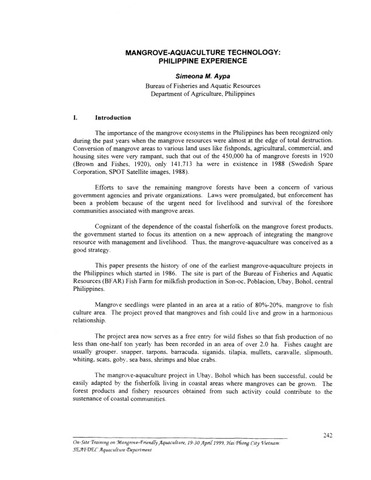Mangrove-aquaculture technology: Philippine experience
Share
Abstract
This paper presents the history of one of the earliest mangrove-aquaculture projects in the Philippines which started in 1986. The site is part of the Bureau of Fisheries and Aquatic Resources (BFAR) Fish Farm for milkfish production in Son-oc, Poblacion, Ubay, Bohol, central Philippines.
Mangrove seedlings were planted in an area at a ratio of 80%-20%. mangrove to fish culture area. The project proved that mangroves and fish could live and grow in a harmonious relationship.
The project area now serves as a free entry for wild fishes so that fish production of no less than one-half ton yearly has been recorded in an area of over 2.0 ha. Fishes caught are usually grouper, snapper, tarpons, barracuda, siganids, tilapia, mullets, caravalle, slipmouth, whiting, scats, goby, sea bass, shrimps and blue crabs.
The mangrove-aquaculture project in Ubay, Bohol which has been successful, could be easily adapted by the fisherfolk living in coastal areas where mangroves can be grown. The forest products and fishery resources obtained from such activity could contribute to the sustenance of coastal communities.
Suggested Citation
Aypa, S. M. (2000). Mangrove-aquaculture technology: Philippine experience. In Y. Tadokoro, V. T. Sulit, & R. B. Abastillas (Comps.), Technologies in Mangrove-Friendly Aquaculture. Final Report of and Papers Presented to the On-Site Training on Mangrove-Friendly Aquaculture, Hai Phong City, Socialist Republic of Vietnam, 19-30 April 1999 (pp. 242–248). Tigbauan, Iloilo, Philippines: Aquaculture Department, Southeast Asian Fisheries Development Center.


